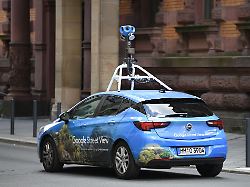Objection must be renewed
Why Google Street View Germany is re-photographing
6/22/2023 7:57 am
Schlecker branches are just one example of the outdated panorama photos of Germany on Google Maps. In view of the great resistance in this country, Google Street View kept its feet still for many years. Now the company is making a fresh start. Citizens can object.
A virtual trip with Google Street View through major German cities is like a journey through time. For example, the panorama photos of the Internet giant still show the branches of the drugstore chain Schlecker, which have long since disappeared from the public eye after the bankruptcy in 2012. While the images of houses, streets and facades for the map application Google Maps were constantly updated worldwide, nothing has changed in Germany since 2010. But now the camera cars from Google are on the road again in this country.
The group announced that the vehicles will drive through town and country from now until October to take new photos. In order to capture certain sights well, employees with a camera backpack are also on foot. The fresh photos as well as pictures from the past year are then to be published step by step from mid-July onwards.
What exactly is Google picking up? Are these videos or photos?
The Google cars do not film videos, but create high-resolution 3D panoramic images every few meters. These will later be linked digitally with software so that the user can move virtually in the streetscape on their smartphone or PC. The total of nine cameras are located at a height of 2.9 meters and also capture street signs and shop lettering. License plates and the faces of passers-by are automatically pixelated.
Is all of Germany recorded?
Generally, yes. Google has announced tracking shots for all major cities and almost all districts in Germany. First, however, the 20 largest cities where the service was previously available are to be gradually updated: Berlin, Bielefeld, Bochum, Bonn, Bremen, Dortmund, Dresden, Duisburg, Düsseldorf, Essen, Frankfurt am Main, Hamburg, Hanover, Cologne, Leipzig , Mannheim, Munich, Nuremberg, Stuttgart and Wuppertal.
Why didn’t Google update the recordings like in other countries?
In contrast to most other countries in the Western world, when Google introduced Street View in Germany in 2010, it met with some strong resistance from politicians, homeowners and data protection officials. Almost a quarter of a million people objected to the footage, forcing Google to pixelate their homes, impacting the overall quality of the service. In 2011, the group then announced that it would not undertake any further tracking shots. It was only twelve years later that the decision to make a new start was matured.
Why was there such a fuss at the time?
In 2010, only a few people in Germany had a smartphone and could hardly imagine how practical it can be to look at a street panorama before a trip or on the go, for example to check what the area around a holiday home looks like. At that time, Google was not able to dispel the many data protection reservations or security concerns in the population, also because the Federal Consumer Protection Minister at the time, Ilse Aigner, created a mood against the service. The reservations about Street View even went so far that many people in Germany took at face value a satirical TV report that allegedly announced that Google would also use its cameras to take pictures in private homes.
What should I do if I don’t want my house to appear on Google Street View?
As in 2010, Google has to redact every apartment or house before publishing the new pictures if tenants or owners want it. However, the old applications from back then are no longer valid and must be re-submitted. The objection can be made by e-mail, by form or by post. Citizens should have every opportunity to assert their right to privacy, says Hamburg’s data protection officer, Thomas Fuchs.
If pixelation was requested before the image was published, the house will only be displayed pixelated in the Street View service from the start. If the objection is only received by Google after publication, the pixelation will take place subsequently. Fuchs has not yet decided how he will behave. “Personally, I will first look at the new footage on Google Street View when it’s released and then decide what to do.”
What does Apple actually do?
Apple’s activities are likely to be an important reason why Google doesn’t want to let its Street View service in Germany rot and instead gets fresh photos. At its WWDC developer conference in 2019, the iPhone group announced the virtually accessible street map Lock Around and has since introduced it almost everywhere in Germany.
Similar to Google, Apple offers homeowners and tenants the option of pixelation of unwanted photos of their house facades upon request. But so far fewer than 100 people have used it. Lock Around can only be used on Apple devices, but makes Google’s map service look old in the truest sense of the word, especially on smartphones.
